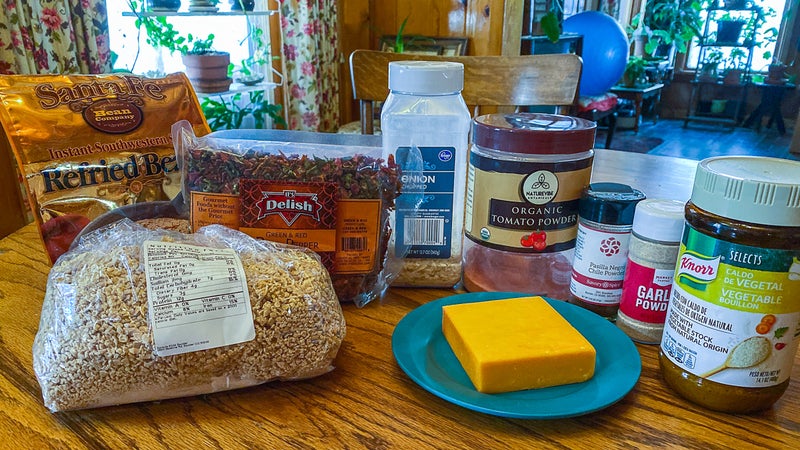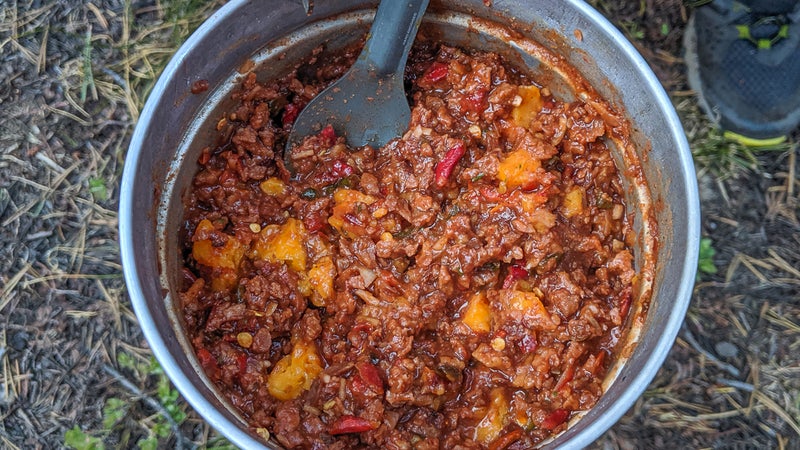I make chili almost every week when I’m at home in the winter. It’s particularly gratifying to make it with elk meat I’ve harvested myself and homegrown peppers and tomatoes.
It seemed like my chili recipe could be converted for backcountry use, so I asked my program manager—who has a degree from the and who works full-time at the , one of the finest restaurants in Boulder, Colorado—to develop one. On its maiden trip, the chili got excellent reviews: “If it had Fritos, I’d score it higher than beans and rice,” said a regular client. If you’ve tried that dish, you know that’s high praise!
Meal Stats
- Recipe weight: 5.5 ounces
- Total calories: 512
- Calories per ounce: 93
Ingredients

We use 11 ingredients and spices in our backcountry version. It’s more work, but the end product justifies the effort. Plus, we’re preparing big batches (more than 100 servings per season), and adding a few extra ingredients only marginally increases the time and expense.
To keep it simple, this meal can be made using just six ingredients. Most are difficult to find locally, however, so this is a poor option for last-minute food planning. The ingredients are easily found online.
- : 1.8 ounces
- : 0.8 ounce
- : 0.7 ounce
- : 0.5 ounce
- : 0.2 ounce
- Cheese: 1 ounce
Our full version differs mostly in the seasonings. Instead of just chili powder, we use:
- : 0.3 ounce
- : 0.3 ounce
- : 0.1 ounce
- : 0.1 ounce
- : 0.1 ounce
Instant refried beans can be found in some grocery stores. (In Boulder, for example, carries them in bulk.) Some brands contain gluten, so read the ingredients label if you’re sensitive.
Tomato powder is a vital base ingredient. A little goes a long way. It’s convenient to have in the pantry for home use.
The most common complaint about this dish is the textured vegetable protein. If you’re unaccustomed to it, it can be difficult to digest (making even a palatial tent too claustrophobic). So consider using more beans and less textured vegetable protein.
Alternatively, substitute dried beef crumbles for the textured vegetable protein. This will significantly increase the cost but will be easier on sensitive systems. Be aware that beef crumbles are not particularly shelf-stable. Once the package is opened, refrigerate it and use it within a week; in the field, use it within a day or two, depending on ambient temperatures.
To increase the calorie count and caloric density, add more cheese, Fritos, or olive oil.
At-Home Preparation
For solo trips, you can mix everything together in a small bag except the cheese, which you should keep in its own bag. Cheese makes most meals better, and on longer trips, I often pack a big block of it.
For groups, you can carry all the ingredients in a single bag and divide it in the field, or you can give each group member an individual ration (as we normally do). Again, hold out the cheese. The spices tend to settle toward the bottom of a bag, and shaking the bag helps redistribute them.
Cooking Instructions
- Bring about 12 ounces of water to a boil.
- Take the pot off the flame. Add all the ingredients except the cheese.
- You can let it sit, covered, for about ten minutes to rehydrate. You can let it simmer, too, stirring so you don’t burn it.
- Mix in the cheese.

As noted in my “” post, I tend to make meals more watery in the backcountry. Using up to 16 ounces of water will help make cleanup easier.


